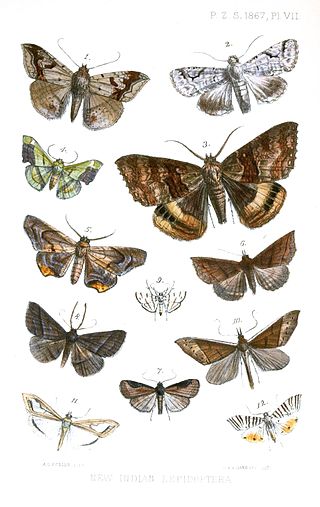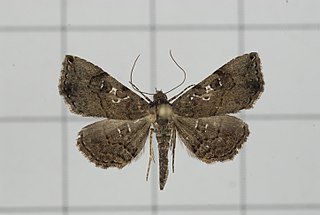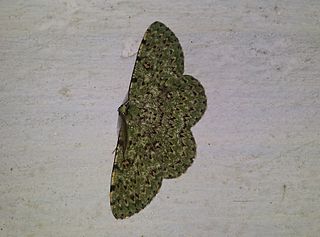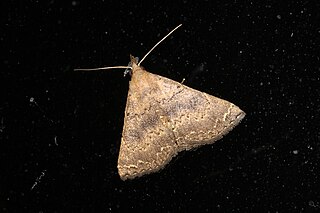
Claterna is a monotypic moth genus of the family Noctuidae erected by Francis Walker in 1858. Its only species, Claterna cydonia, was first described by Pieter Cramer in 1775.

Egnasia is a genus of moths of the family Erebidae. The genus was first described by Francis Walker in 1859.
Nolasena is a monotypic moth genus of the family Erebidae. Its only species, Nolasena ferrifervens, is found in India, Sri Lanka, Borneo and the Philippines. Both the genus and species were first described by Francis Walker in 1858.

Symmacra is a monotypic moth genus in the family Geometridae described by Warren in 1896. Its only species, Symmacra solidaria, was first described by Achille Guenée in 1858. It is found in Indo-Australian tropics of India, Sri Lanka, Borneo east to Fiji, Samoa and Australia.

Bamra albicola is a moth of the family Noctuidae first described by Francis Walker in 1858.

Bamra mundata is a moth of the family Noctuidae first described by Francis Walker in 1858. It is found in India and Sri Lanka, Caterpillars are known to feed on Albizia and Arachis hypogaea.
Brana is a monotypic moth genus of the family Noctuidae. Its only species, Brana calopasa, is found in Sri Lanka and Australia. Both the genus and species were described by Francis Walker, the genus in 1858 and the species in 1859. It It is a serious pest on Berrya cordifolia.

Caduca albopunctata is a moth of the family Noctuidae first described by Francis Walker in 1857.

Egnasia ephyrodalis is a moth of the family Noctuidae first described by Francis Walker in 1858.
Egnasia participalis is a moth of the family Noctuidae first described by Francis Walker in 1891. It is found in India and Sri Lanka. It has a 28 mm wingspan, a yellow-colored body and a forewing with the lunulate hyaline (glass-like) mark at the end of the cell. The outer lines of both wings are slightly sinuous. In the hindwing, the outer line rises from near the apex.

Rhesala imparata is a moth of the family Erebidae first described by Francis Walker in 1865. It is sometimes referred to as an Albizia defoliator. It is found in Sri Lanka, India, Taiwan, Singapore and Borneo.

Anomis mesogona is a moth of the family Erebidae first described by Francis Walker in 1857. It is found in India, Sri Lanka, Somalia and Japan.

Amblychia angeronaria is a moth of the family Geometridae first described by Achille Guenée in 1858. It is found in Sri Lanka, northern India, Korea, Andaman Islands to Taiwan, Borneo, Sumatra, Korea Japan and Australia.
Chorodna strixaria is a moth of the family Geometridae first described by Achille Guenée in 1858. It is found in India, Vietnam, Sulawesi, the Philippines, the Moluccas, New Guinea, Australia and Sri Lanka.
Luxiaria phyllosaria is a moth of the family Geometridae first described by Francis Walker in 1860. It is found in Sri Lanka, the north-eastern Himalayas of India, Sumatra, Borneo, the Philippines and Sulawesi.

Ophthalmitis herbidaria is a moth of the family Geometridae first described by Achille Guenée in 1858. It is found in China, India, Sri Lanka, Nepal, Hong Kong and Taiwan.

Progonia oileusalis is a species of moth in the family Noctuidae first described by Francis Walker in 1859. It is found in Sri Lanka, Borneo, India, Taiwan, Japan and the Philippines.
Penicillaria lineatrix is a moth of the family Noctuidae first described by Francis Walker in 1858. It is found in India and Sri Lanka.
Autoba olivacea, the brinjal leaf roller, is a moth of the family Erebidae. The species was first described by Francis Walker in 1858. It is found in several African countries such as Botswana, Eritrea, Madagascar, Malawi, Mozambique, Nigeria, South Africa, Tanzania, Uganda and Zimbabwe. It is also found in Sri Lanka. and India.

Maceda mansueta is a moth of the family Nolidae first described by Francis Walker in 1857. It is found in Japan, Sri Lanka, Borneo, India (Andamans), Malaysia, New Guinea, Fiji, Australia, Réunion and the Seychelles.












